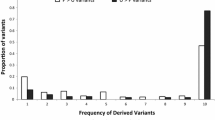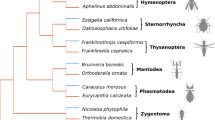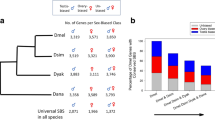Abstract
Genes encoding reproductive proteins often diverge rapidly due to positive selection on nucleotide substitutions. While this general pattern is well established, the extent to which specific reproductive genes experience similar selection in different clades has been little explored, nor have possible targets of positive selection other than nucleotide substitutions, such as indels, received much attention. Here, we inspect for the signature of positive selection in the genes encoding five accessory gland proteins (Acps) (Acp26Aa, Acp32CD, Acp53Ea, Acp62F, and Acp70A) originally described from Drosophila melanogaster but with recognizable orthologues in the D. pseudoobscura subgroup. We compare patterns of selection within the D. psuedoobscura subgroup to those in the D. melanogaster subgroup. Similar patterns of positive selection were found in Acp26Aa and Acp62F in the two subgroups, while Acp53Ea and Acp70A experienced purifying selection in both subgroups. These proteins have thus remained targets for similar types of selection over long (>21-MY) periods of time. We also found several indel substitutions and polymorphisms in Acp26Aa and Acp32CD. These indels occur in the same regions as positively selected nucleotide substitutions for Acp26Aa in the D. pseudoobscura subgroup but not in the D. melanogaster subgroup. Rates of indel substitution within Acp26Aa in the D. pseudoobscura subgroup were up to several times those in noncoding regions of the Drosophila genome. This suggests that indel substitutions may be under positive selection and may play a key role in the divergence of some Acps.


Similar content being viewed by others
References
Aigaki T, Fleischmann I, Chen PS, Kubli E (1991) Ectopic expression of sex peptide alters reproductive behavior of female Drosophila melanogaster. Neuron 7:557–563
Beckenbach AT, Wei YW, Liu H (1993) Relationships in the Drosophila obscura species group, inferred from mitochondrial cytochrome oxidase II sequences. Mol Biol Evol 10:619–634
Begun DJ, Whitley P, Todd BL, Waldrip-Dail HM, Clark AG (2000) Molecular population genetics of male accessory gland proteins in Drosophila. Genetics 156:1879–1888
Britten RJ, Rowen L, Williams J, Cameron RA (2003) Majority of divergence between closely related DNA samples is due to indels. Proc Natl Acad Sci USA 100:4661–4665
Chapman T, Liddle LF, JKalb JM, Wolfner MF, Partridge L (1995) Cost of mating in Drosophila melanogaster females is mediated by male accessory gland products. Nature 373:241–244
Chapman T, Herndon LA, Heifetz Y, Partridge L, Wolfner M F (2001) The Acp26Aa seminal fluid protein is a modulator of early egg-hatchability in Drosophila melanogaster. Proc Roy Soc Lond B 268:1647–1654
Chen PS, Stumm-Zollinger E, Aigaki T, Balmer J, Bienz M, Bohen P (1988) A male accessory gland peptide that regulates reproductive behaviour of female D. melanogaster. Cell 54:291–298
Civetta A, Singh RS (1995) High divergence of reproductive tract proteins and their association with postzygotic reproductive isolation in Drosophila melanogaster and Drosophila virilis group species. J Mol Evol 41:1085–1095
Civetta A, Singh RS (1998) Sex-related genes, directional sexual selection, and speciation. Mol Biol Evol 15:901–909
Clark AG, Aguadé M, Prout T, Harshman LG, Langley CH (1995) Variation in sperm displacement and its association with accessory gland protein loci in Drosophila melanogaster. Genetics 139:189–201
Deely JJ Lindley DV (1981) Bayes empirical Bayes. J Am Stat Assoc 76:833–841
Denver DR, Morris K, Lynch M, Thomas WK (2004) High mutation rate and predominance of insertions in the Caenorhabditis elegans nuclear genome. Nature 430:679–682
Dixon SM, Coyne JA, Noor MAF (2003) The evolution of conspecific sperm precedence in Drosophila. Mol Ecol 12:1179–1184
Gloor GB, Engels WR (1992) Single-fly DNA preps for PCR. Droso Inform Serv 71:148–149
Halligan DL, Eyre-Walker A, Andolfatto P, Keightley PD (2004) Patterns of evolutionary constraints in intronic and intergenic DNA of Drosophila. Genet Res 14:273–279
Harshman LG, Prout T (1994) Sperm displacement without sperm transfer in Drosophila melanogaster. Evolution 48:758–766
Heifitz Y, Tram U, Wolfner MF (2001) Male contributions to egg production:the role of accessory gland products and sperm in Drosophila melanogaster. Proc Roy Soc Lond B 268:175–180
Hellberg ME, Moy GM, Vacquier VD (2000) Positive selection and propeptide repeats promote rapid interspecific divergence of a gastropod sperm protein. Mol Biol Evol 17:458–466
Herndon LA, Wolfner MF (1995) A Drosophila seminal fluid protein, Acp26aa, stimulates egg laying in females for 1 day after mating. Proc Natl Acad Sci USA 92:10114–10118
Holloway AK, Begun DJ (2004) Molecular evolution and population genetics of duplicated accessory gland protein genes in Drosophila. Mol Biol Evol 21:1625–1628
Hudson RR, Kaplan NL (1985) Statistical properties of the number of recombination events in the history of a sample of DNA sequences. Genetics 111:147–164
Hughes AL, Nei M (1988) Pattern of nucleotide substitution at major histocompatibility complex class I loci reveals overdominant selection. Nature 335:167–170
Kern AD, Jones CD, Begun DJ (2004) Molecular population genetics of male accessory gland proteins in the Drosophila simulans complex. Genetics 167:725–735
Lung O, Tram U, Finnerty C, Eipper-Mains M, Kalb J, Wolfner MF (2002) The Drosophila melanogaster seminal fluid protein Acp62F is a protease inhibitor that is toxic upon ectopic expression. Genetics 160:211–224
Machado CA, Kliman RM, Markert JA, Hey J (2002) Inferring the history of speciation from multilocus sequence data: the case of Drosophila pseudoobscura and its close relatives. Mol Biol Evol 19:472–488
McCartney MA, Lessios HA (2004) Adaptive evolution of sperm bindin tracks egg incompatibility in neotropical sea urchins of the genus Echinometra. Mol Biol Evol 21:732–745
McDonald JH, Kreitman M (1991) Adaptive protein evolution at the Adh locus in Drosophila. Nature 351:652–654
Metz EC, Palumbi SR (1996) Positive selection and sequence rearrangements generate extensive polymorphism in the gamete recognition protein bindin. Mol Biol Evol 13:397–406
Mueller JL, Ravi Ram K, McGraw LA, Bloch Qazi MC, Siggia ED, Clark AG, Aquadro CF, Wolfner MF (2005) Cross-species comparison of Drosophila male accessory gland protein genes. Genetics 171:131–143
Neilsen R, Yang Z (1998) Likelihood models for detecting positively selected amino acid sites and applications to the HIV-1 envelope gene. Genetics 148:929–936
Neubaum DM, Wolfner MF (1999) Mated Drosophila melanogaster females require a seminal fluid protein, Acp36DE, to store sperm efficiently. Genetics 153:845–857
Palomino MM, Meyers BC, Michelmore RW, Gaut BS (2002) Patterns of positive selection in the complete NBS-LRR gene family of Arabidopsis thaliana. Genet Res 12:1305–1315
Panhuis TM, Swanson WJ, Nunney L (2003) Population genetics of accessory gland proteins and sexual behaviour in Drosophila melanogaster populations from Evolution Canyon. Evolution 57:2785–2791
Podlaha O, Zhang J (2003) Positive selection on protein-length in the evolution of a primate sperm ion channel. Proc Natl Acad Sci USA 100:12241–12246
Podlaha O, Webb DM, Tucker PK, Zhang J (2005) Positive selection for indel substitutions in the rodent sperm protein Catsper1. Mol Biol Evol 22:1845–1852
Ren DJ, Navarro B, Perez G, Jackson AC, Hsu SF, Shi Q, Tilly JL, Clapham DE (2001) A sperm ion channel required for sperm motility and male fertility. Nature 413:603–609
Richards S, Liu Y, Bettencourt BR, Hradecky P, Letovsky S, Nielsen R, Thornton K, Hubisz MJ, Chen R, Meisel RP, Couronne O, Hua S, Smith MA, Zhang P, Liu J, Bussemaker HJ, van Batenburg MF, Howells SL, Scherer SE, Sodergren E, Matthews BB, Crosby MA, Schroeder AJ, Ortiz-Barrientos D, Rives CM, Metzker ML, Muzny DM, Scott G, Steffen D, Wheeler DA, Worley KC, Havlak P, Durbin KJ, Egan A, Gill R, Hume J, Morgan MB, Miner G, Hamilton C, Huang Y, Waldron L, Verduzco D, Clerc-Blankenburg KP, Dubchak I, Noor MAF, Anderson W, White KP, Clark AG, Schaeffer SW, Gelbart W, Weinstock GM, Gibbs RA (2005) Comparative genome sequencing of Drosophila pseudoobscura: chromosomal, gene, and cis-element evolution. Genet Res 15:1–18
Rozas J, Sánchez-DelBarrio JC, Messegyer X, Rozas R (2003). DnaSP, DNA polymorphism analyses by the coalescent and other methods. Bioinformatics 19:2496–2497
Saitou N, Nei M (1987) The neighbor-joining method: a new method for reconstructing phylogenetic trees. Mol Biol Evol 4:406–425
Singh RS, Kulathinal RJ (2000) Sex gene pool evolution and speciation: a new paradigm. Genes Genet Syst 75:119–130
Sokal RR, Rohlf FJ (1995) Biometry. W.H. Freeman, New York
Stevison LS, Counterman BA, Noor MAF (2004) Molecular evolution of X-linked accessory gland proteins in Drosophila pseudoobscura. J Hered 95:114–118
Suzuki Y, Nei M (2004) False positive selection identified by ML-based methods: examples from the sig1 gene of the diatom Thalassiosira weissflogii and the tax gene of a human T-cell lymphotropic virus. Mol Biol Evol 21:914–921
Swanson WJ, Vacquier VD (1998) Concerted evolution in an egg receptor for a rapidly evolving abalone sperm protein. Science 281:710–712
Swanson WJ, Vacquier VD (2002) Reproductive protein evolution. Annu Rev Ecol Syst 33:161–179
Swanson WJ, Clark AG, Waldrip-Dail HM, Wolfner MF, Aquadro CF (2001) Evolutionary EST analysis identifies rapidly evolving male reproductive proteins in Drosophila. Proc Natl Acad Sci USA 98:7375–7379
Swanson WJ, Nielsen R, Yang Q (2003) Pervasive adaptive evolution in mammalian fertilization proteins. Mol Biol Evol 20:18–20
Swofford DL (2001) PAUP*. Phylogenetic Analysis Using Parsimony (*and other methods). Version 4. Sinauer Associates, Sunderland, MA
Tajima F (1989) Statistical method for testing the neutral mutation hypothesis by DNA polymorphism. Genetics 123:585–595
Tsaur SC, Wu C-I (1997) Positive selection and the molecular evolution of a gene of male reproduction, Acp26Aa of Drosophila. Mol Biol Evol 14:544–549
Tsaur SC, Ting CT, Wu C-I (2001) Sex in Drosophila mauritiana: extremely high level of replacement polymorphism in a male reproductive gene. Mol Biol Evol 18:22–26
Wagstaff BJ, Begun DJ (2005) Comparative genomics of accessory gland protein genes in Drosophila melanogaster and D. pseudoobscura. Mol Biol Evol 22:818–832
Wolfner MF (2002) The gifts that keep on giving: physiological functions and evolutionary dynamics of male seminal proteins in Drosophila. Heredity 88:85–93
Wong WSW, Yang Z, Goldman N, Nielsen R (2004) Accuracy and power of statistical methods for detecting adaptive evolution in protein coding sequences and for identifying positively selected sites. Genetics 168:1041–1051
Xue L, Noll M (2000) Drosophila female sexual behavior induced by sterile males showing copulation complementation. Proc Natl Acad Sci USA 97:3272–3275
Yang Z (2004) A probabilist’s account of modern molecular population genetics. Heredity 92:474
Yang Z, Swanson WJ (2002) Codon substitution models to detect adaptive evolution that account for heterogeneous selective pressures among site classes. Mol Biol Evol 19:49–57
Yang Z, Nielsen N, Goldman N, Pedersen A-M (2000) Codon-substitution models for heterogeneous selection pressure at amino acid sites. Genetics 155:431–449
Yang Z, Wong WSW, Nielsen R (2005) Bayes empirical Bayes inference of amino acid sites under positive selection. Mol Biol Evol 22:1107–1118
Zhang J (2004) On the evolution of codon volatility. Genetics 169:495–501
Zigler KS, Lessios HA (2004) Speciation on the coasts of the New World: phylogeography and the evolution of bindin in the sea urchin genus Lytechinus. Evolution 58:1225–1241
Acknowledgments
We thank Carlos Machado and Mohamed Noor for providing fly stocks and Kevin Schully and Pat Arbour-Reily for technical help. We thank Daniel Ortiz-Barrientos, Mike Taylor, Mariana Wolfner, Willie Swanson, and two anonymous reviewers for critical reviews and helpful discussions. Sequencing expenses were supported in part by an NSF Multiuser Equipment Grant (DBI-0400797) to the LSU Museum of Natural Sciences.
Author information
Authors and Affiliations
Corresponding author
Additional information
[Reviewing Editor: Dr. Willis Swanson]
Electronic Supplementary Material
Rights and permissions
About this article
Cite this article
Schully, S.D., Hellberg, M.E. Positive Selection on Nucleotide Substitutions and Indels in Accessory Gland Proteins of the Drosophila pseudoobscura Subgroup. J Mol Evol 62, 793–802 (2006). https://doi.org/10.1007/s00239-005-0239-4
Received:
Accepted:
Published:
Issue Date:
DOI: https://doi.org/10.1007/s00239-005-0239-4




